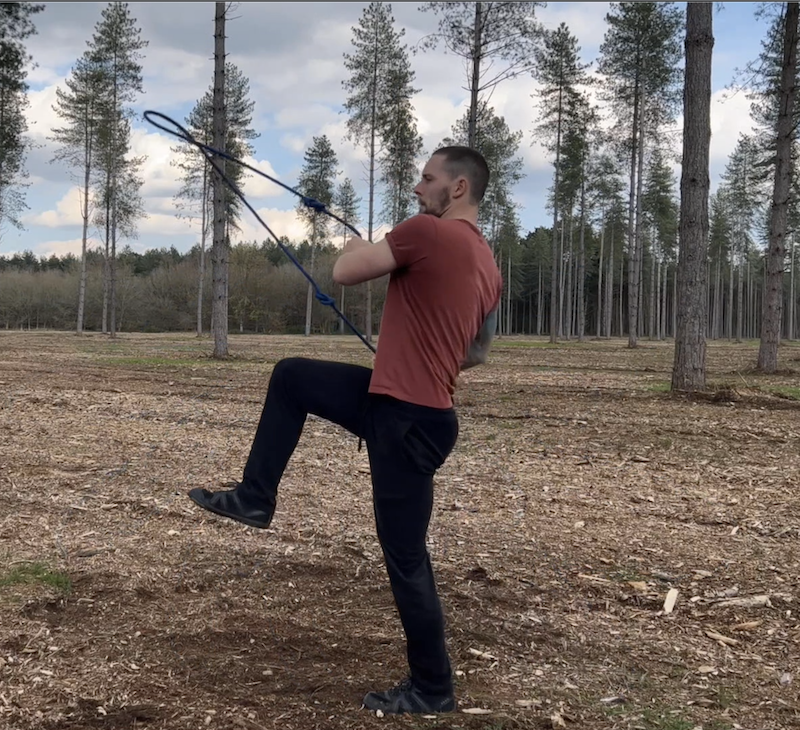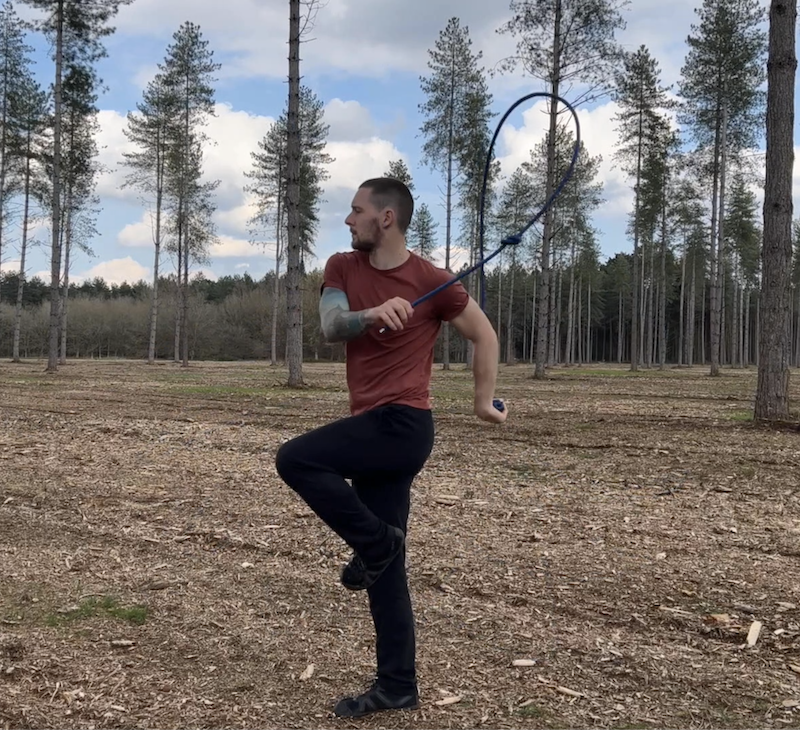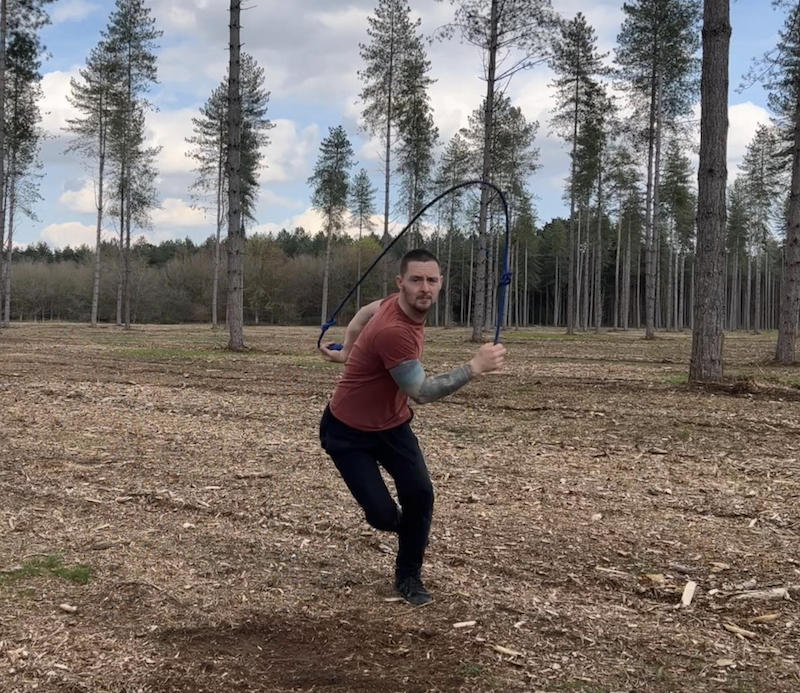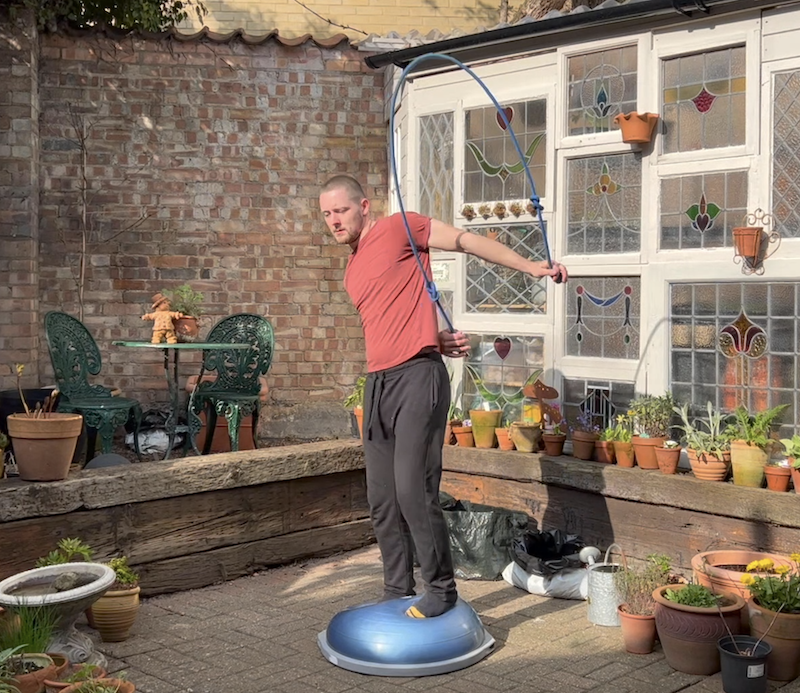Strengthening Your Foundation: The Importance of Balance Training With Rope Flow
Balance is an essential aspect of fitness and daily life. It helps us maintain stability and coordination, prevent falls and injuries, and enhances our athletic performance. One effective way to train your balance is through rope flow exercises, which can challenge your stability and coordination in various planes of motion. In this blog post, we’ll explore some effective rope flow exercises to train your balance and improve your overall fitness.

Rest One Foot on the Other Knee
This exercise involves standing on one leg and resting the other foot on your knee. It is an effective way to actively coordinate your body whilst on one leg. Recommended patterns to perform in this position are predominantly the underhand ones, such as figure-8s or alternating sneaks. This exercise challenges your balance and stability in a static position, making it a great starting point for beginners. A key point to remember is that we’re aiming to reduce the spillage of energy in the top half of our body to allow the lower half to balance itself. The more unnecessary wasteful movements up top, the harder your foot and lower leg must fight to keep you balanced.
If you’re new to this exercise, I’d recommend starting off with a short period of time such as 5-10s on one leg before switching to the other side. Over time you can increase this so that eventually you can balance for several minutes at a time on one leg.
This exercise can be challenging for individuals with knee or hip issues. If you experience any discomfort, you may need to stop and assess your posture to see where the body is overcompensating and causing you pain.

One Foot Suspended
This exercise involves standing on one foot while suspending the other foot in the air whilst performing underhand patterns. It is a more challenging exercise than the previous one and requires more stability and coordination.
This exercise targets your lower body muscles, particularly your glutes, as they must work to drive your leg into extension and keep the body upright, whilst the hip flexors on the opposite leg must work to raise your knee. This closely resembles the sequencing of muscle activation during locomotion, making it incredibly functional. It can help improve your balance and posture and has tremendous carryover to running whilst making it easier to perform other exercises and daily activities.
Similarly to the previous exercise, you may wish to train this for a set time on each leg. Another effective variation I like to do is to perform 3 reps of underhand alternating sneaks on one leg and then switching to the other leg repeatedly (See an example of this at 3:35 [clickable link] in the YouTube video)
Dragon Roll on One Leg
This exercise involves standing on one leg while performing a dragon roll and rotating your torso in the transverse plane. It challenges your thoracic rotation and coordination, making it an effective exercise for improving your balance and stability. To perform this exercise, put your weight on one leg. You will then perform a dragon roll in the direction of the other leg (the rope comes behind the body and crosses over to the other side of the body as it comes over your head). Once you have established a steady pace, start to raise the leg without weight on it and drive it forwards and backwards in time with the rope. You should be driving it forwards as the rope comes behind your back and driving it backwards as the rope comes in front of you.
Locomotion Exercises
Lateral Bounds
This exercise involves jumping laterally while maintaining your balance and stability. It is a great exercise for improving quick changing of direction, making it ideal for athletes. To perform this exercise, initiate the movement by performing an underhand sneak at the same time as turning into the hip on the opposite site of the body that the rope passes (see video for a clear demonstration). Once you have loaded this glute and primed it to explode, jump from that leg sideways over to the other leg in time with the rope and land on the opposite leg. Simply repeat this on the other side by jumping back to your starting position. Start off with small jumps and work your way up to increasingly sideward bounds.

Multidirectional Bounds
This exercise is similar to the lateral bounds but involves jumping in multiple directions. It challenges your coordination and stability in different planes of motion, making it a more challenging exercise than the lateral bounds. To perform this exercise, set up in the same way as you would for lateral bounds but this time vary the exercise by jumping both forwards and backwards as you hop from one leg to the other, maintaining your balance and stability.
UH Mat Step Complex
This exercise involves targeting mostly the glute on one side of the body at a time and is excellent for training our hip extension. Let’s say we want to train our left glute, the most crucial aspect to remember is that we always keep out weight above our left hip throughout the entire exercise. Here’s how it’s performed without the rope first: To initiate the move, step back with your right leg whilst your left knee bends and you load your left glute by stretching it under tension whilst your upper body tilts down into a slight flexion. Then, extend your knee and hip to drive your body upright and raise the right leg off the ground, driving the knee up and forwards. Do not be tempted to fall forwards, as we are going to return this leg back behind the body to begin the next rep.

Once you are comfortable with this movement, it’s time to add the rope and increase the challenge to the body. Now try to incorporate underhand matadors into the movement and incorporate the upper body with the lower. As the left knee bends, perform two beats of UH matador on the left side of your body, and as you swing the rope over to the other side, that’s when you extend the leg and raise the right knee up and forwards whilst you perform the matador on the right side. Return the right leg to the start and repeat.
Bonus Exercises
Balance on a Bosu Ball
This exercise involves standing on a Bosu ball while maintaining your balance and stability and experimenting with your favourite rope flows. Something to try once you feel comfortable on a bosu ball is experimenting with releases and wraps as they will train your hand-eye coordination whilst the legs must work the keep the body balanced.

Balance on a Medicine Ball
A great progression from the bosu ball is to balance on a slam ball or medicine ball as it offers slightly more instability than a bosu ball. Be very careful when trying this so as not to fall and injure yourself!
Balance on a Swiss Ball
Finally, the most challenging of these exercises is to perform rope flow whilst balancing on a swiss ball. This offers the least stability of all three and is one to try only once having mastered the previous two and developing an advanced level of balance. Why not make it your goal to reach this level?
In conclusion, balance is an essential aspect of fitness that helps maintain stability and coordination, prevent falls and injuries, and enhance athletic performance. Rope flow exercises provide an effective way to train your balance, challenging your stability and coordination in various planes of motion. Starting with the most basic of exercises involving balancing on one leg, progressing to mobile exercises such as lateral bounds, and then introducing an added degree of challenge by making use of Bosu balls, medicine balls or Swiss balls, can all help improve your balance and overall fitness. Incorporating these exercises into your workout routine can help you achieve better balance, stability, and coordination, leading to improved physical performance and a better quality of life.

No comment